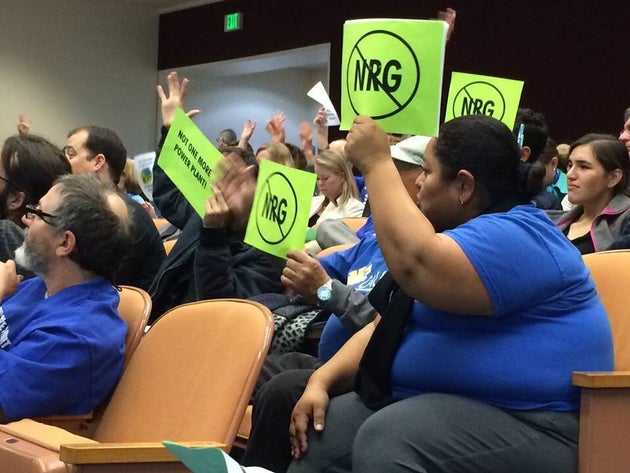Oxnard, California: The City That Stopped A Gas Plant

When NRG Energy, one of the largest electric power producers in the country, won a contract to build a new gas plant on the beach in Oxnard, California, in 2014, nearly everyone assumed it was a done deal.
The region’s electric utility, Southern California Edison, needed a new source of power to keep the lights on in moments of extreme need. But the working class, majority-Latino community was not enthused about the prospect of another industrial facility in its backyard. Power plants already bookend Oxnard’s beach, about seven miles apart, the smokestacks looming over the coastal vista. A toxic Superfund site lingers nearby, the aftermath of a smelting plant that shut down years ago.
Local activists and city officials rejected the expectation that they should host another major polluter. They passed an ordinance to block new plants on the coast, and demanded that the state look for cleaner alternatives.
Such objections had failed to stop many a gas plant before, but this time, things veered off the usual playbook.
California leaders were already working to eliminate greenhouse gases from the power sector and curb the state’s considerable contribution to climate change. A new ecosystem of clean energy companies emerged to provide equipment and software to generate and store electricity.
When state officials inquired in 2017 whether clean technologies could fill the role of NRG’s gas plant, the answer was a definite yes. With that knowledge, regulators said they would reject the gas plant due to its environmental impact, and asked Southern California Edison to find clean energy projects to replace it.
The utility came back two months ago with a different vision for the city: a suite of batteries that can store the abundant solar power generated during the day and deliver it when needed.
This is the story of how Oxnard became a test case for California’s effort to end reliance on fossil fuels and a model for communities struggling with their own contested power plants.
Getting Out The Ground Game
For NRG, the Puente plant was an effective answer to energy needs that state authorities had identified in 2013 as they prepared for several older plants to shut down.
But for residents, the proposed plant was another entry in a long history of having their home treated as a “dumping ground for industrial facilities,” said Lucas Zucker, policy director at grassroots advocacy group Central Coast Alliance United for a Sustainable Economy (CAUSE).
Oxnard’s population, roughly 200,000, is three-quarters Latino and more than one-third foreign-born. Many residents work in the fields that surround the municipality. Unlike wealthier beach towns nearby, like Santa Barbara or Malibu, Oxnard’s strip of coastline doubled as an industrial zone.
“Oxnard has for decades borne the health and safety impacts and nuisances of several power plants in its community to power the entire region,” said Gladys Limón, executive director of the California Environmental Justice Alliance (CEJA), which advocates at the state level on behalf of 10 local environmental justice groups, including CAUSE, to relieve the disproportionate burden of pollution on low-income communities and people of color.

RENE GARCIA/CAUSE
Limón grew up in Oxnard and recalled the eerie presence of one of the gas plants haunting her childhood beach outings.
“People just stay away from it,” she said. “You inherently don’t want to go near it.”
CAUSE took the lead in organizing opposition to Puente, encouraging residents to show up for hearings and explain why they didn’t want new fossil fueled infrastructure popping up near their homes and occupying their beach.
Spurred by the turnout, the city council joined the activists in opposition, unanimously passing an ordinance in July 2014 temporarily blocking new power plant construction on the coast. Mayor Pro Tem Carmen Ramírez, who proposed the measure, worked at CAUSE prior to running for office and said she didn’t want to sacrifice the community’s coastline and the health of people living near it.
Despite the local objections, the power plant regulators at the California Public Utilities Commission approved Puente’s contract in June 2016. The only thing NRG needed before starting construction was certification from the California Energy Commission, which regulates the environmental impacts of power plants.
“People became really frustrated,” Zucker recalled of that setback. “They felt like they were exercising their democratic voice in every way possible and not having much to show for it.”
When the local ordinance failed to stop the plant, city leaders spent around half a million dollars to fight Puente in the ongoing regulatory process, Ramírez said. They also found expert witnesses to testify about how sea level rise could threaten the proposed power plant, and whether clean energy could fulfill local grid requirements.
“When the city opposes something, it has a little more weight,” she said.
As the regulatory process dragged on for months, seemingly out of the community’s hands, attendance and excitement at the hearings started to wane, Zucker noted.
The tide turned in January 2017. Roughly 30 youth activists shut down a California Energy Commission (CEC) meeting in Oxnard by standing up and chanting “No more power plants; we say no,” until officials from the regulator and NRG left the room, local outlet VC Star reported. That civil disobedience attracted broader media attention, and in February, eight state senators signed a letter expressing “deep concern” about Puente’s coastal setting.
That set the stage for another deviation from normal process.
The California Independent System Operator, which oversees grid operations, offered to study clean alternatives to the gas plant. That sort of back-to-the-drawing-board approach does not usually happen once a project has approval from the utility and the PUC. CAUSE and others pushed hard for that research to happen, and the CEC allowed it, to further inform their own decision.
That study concluded that renewables and energy storage could do the job of the proposed gas plant. The CEC commissioners, in turn, indicated they wanted to reject Puente, and nudged the utility to investigate what clean alternatives developers could offer to address the region’s energy needs.

CEJA
Clean energy providers turned out in force; the utility received 341 proposals (some of which incorporated natural gas). Based on that response, the utility advised the gas plant developer that its plant was no longer needed, NRG spokesperson David Knox said in an emailed statement. NRG withdrew its application.
From One Option To Many
The whole point of Puente was to make sure that Oxnard and surroundings had enough fast-response power supply to carry them through moments of extreme need.
The region sits wedged between the Pacific Ocean and coastal mountains, connected to the broader grid by three major transmission wires. Two of the half dozen or so coastal gas plants in the region are set to shut down by 2021 because of an environmental regulation banning plants that use ocean water for cooling. Two more units are slated to retire for other reasons.
That leaves the area vulnerable to energy shortages if something like a wildfire, mudslide or earthquake cut off the wires that connect to the broader grid.
As a “peaker” plant, Puente’s job would have been to sit around most of the time, and respond quickly if that scenario arrived.
In the time it took to develop plans for Puente, the clean energy industry grew up. Batteries couldn’t compete with gas plants during the initial bidding five years ago; now they can, at least in certain places. Meanwhile, California passed a new state law in 2018 committing to 100 percent clean electricity by 2045.
To decarbonize the grid, California has to stop building new fossil fuel plants, then find a way to close existing ones. But wind or solar power cannot dispatch on demand, making them imperfect replacements for gas plants; that’s why storage plays a crucial role in the future of the grid.
When regulators called for a fresh look at Puente, they had many other options. What they selected contains a 100-megawatt battery from developer Strata Solar, which will be one of the largest in the world when it comes online in December 2020. The winners included several other large grid batteries and a contract with Swell Energy, which puts batteries in homes. Regulators still need to officially approve these projects.
This is still something of an experiment. Gas plants and batteries do not work the same way. A battery runs out of juice after a certain number of hours, while a gas plant keeps going. That difference could prove significant in, say, a prolonged heat wave.
On the other hand, batteries actually respond faster than a gas plant can, and the distributed nature of the portfolio eliminates a single point of failure. The new approach coordinates multiple, smaller plants to deliver the same service as the one larger facility.
The batteries can also charge up when electricity is cheap or free, thanks to California’s surplus of midday solar power, and make money in the state’s wholesale markets when they are not otherwise needed. They offer a different economic calculus than the classic gas peaker.
Crucially, regulators, utility analysts and grid operators all deemed energy storage ready to serve this particular role in Oxnard. That doesn’t mean California’s biggest gas plants are under threat just yet ― gas still produces about one-third of California’s electricity annually.
The outcome does put other peaker plants on notice, and sets a precedent for considering clean technologies for future projects, because gas is no longer the only viable option.
“The victory in defeating the proposed power plant was a pivotal turning point for the state,” Limón said. “Expanding fossil fuel operations as a matter of course is really a thing of the past.”
Cleaner Power, Transferable Lessons
Regulators have started to block gas plants elsewhere, even in markedly different places like in Arizona and Indiana. But many more plants still earn approval with minimal controversy.
“It’s definitely a battle no one expected us to win,” Zucker said. “These projects always get approved.”
Perhaps the biggest lesson other communities could learn from Oxnard is the value of making sure all available technologies get considered. That may not happen without a push.
“The technology is available,” Limón said. “It’s really now just a matter of political will.”
Mobilizing political will around the finer points of grid reliability can be challenging, though.
“Put people front and center,” Zucker said. “It’s easy to get lost in the wonky details, but in the end our most powerful message was, ‘Clean air for Oxnard.’”
For Ramírez, on the City Council, the key was having a diverse coalition bringing different strengths.
“You need scientists, you need lawyers and you need the community organizing,” she said. “You need elected officials that are responsive to the people.”














